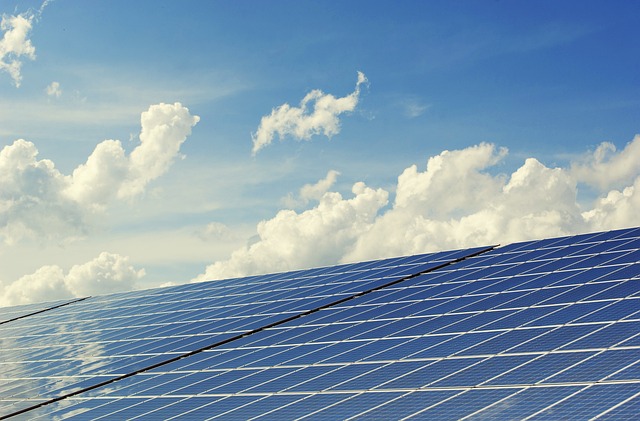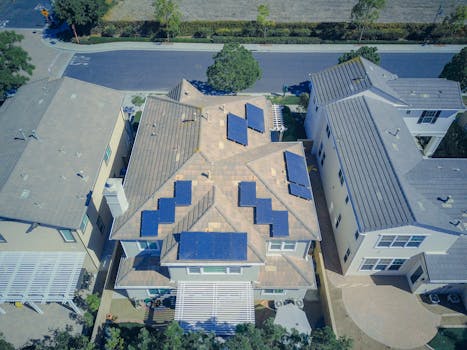“Empowering Tomorrow: Innovative Solar Mounting Systems for Maximum Energy Efficiency.”
Innovative solar mounting systems play a crucial role in enhancing the efficiency and effectiveness of solar energy solutions. These advanced systems are designed to optimize the installation and performance of solar panels, ensuring maximum exposure to sunlight while minimizing land use and installation costs. By incorporating cutting-edge materials and engineering techniques, these mounting solutions provide greater durability, flexibility, and adaptability to various environments and applications. As the demand for renewable energy continues to rise, innovative solar mounting systems are essential for facilitating the widespread adoption of solar technology, ultimately contributing to a more sustainable and energy-efficient future.
Advanced Solar Mounting Technologies
The evolution of solar energy technology has been marked by significant advancements in solar mounting systems, which play a crucial role in optimizing the efficiency and effectiveness of solar panels. As the demand for renewable energy sources continues to rise, innovative solar mounting technologies have emerged, addressing the need for more efficient energy solutions. These advanced systems not only enhance the performance of solar installations but also contribute to the overall sustainability of energy production.
One of the most notable advancements in solar mounting technology is the development of adjustable mounting systems. These systems allow for the tilt and orientation of solar panels to be modified according to seasonal changes and geographical location. By optimizing the angle of incidence, adjustable mounts can significantly increase the amount of sunlight captured throughout the year. This adaptability is particularly beneficial in regions with varying weather patterns, where maximizing solar exposure can lead to substantial energy gains.
In addition to adjustable mounts, the introduction of lightweight materials has revolutionized solar mounting systems. Traditional mounting structures often relied on heavy metals, which not only increased installation costs but also posed challenges in terms of transportation and labor. However, the use of advanced composites and aluminum alloys has led to the creation of lightweight, durable mounting solutions that are easier to handle and install. This shift not only reduces the overall carbon footprint of solar installations but also allows for greater flexibility in design and application, making solar energy more accessible to a wider range of users.
Moreover, the integration of smart technology into solar mounting systems has further enhanced their efficiency. Smart mounts equipped with sensors can monitor environmental conditions, such as temperature and sunlight intensity, and adjust the positioning of solar panels in real-time. This dynamic response to changing conditions ensures that solar panels operate at peak efficiency, maximizing energy production. Additionally, these smart systems can provide valuable data analytics, allowing users to track performance metrics and optimize their energy consumption patterns.
Another innovative approach in solar mounting technology is the use of building-integrated photovoltaics (BIPV). This method involves integrating solar panels directly into building materials, such as roofs and facades, effectively transforming structures into energy-generating assets. BIPV not only enhances the aesthetic appeal of buildings but also eliminates the need for separate mounting systems, streamlining the installation process. As urban areas continue to grow, BIPV presents a viable solution for harnessing solar energy without compromising valuable space.
Furthermore, the rise of solar tracking systems has marked a significant leap in solar mounting technology. These systems utilize motors and gears to follow the sun’s path across the sky, ensuring that solar panels are always positioned for optimal sunlight exposure. By increasing the amount of direct sunlight received, solar trackers can boost energy production by up to 25% compared to fixed installations. This technology is particularly advantageous for large-scale solar farms, where maximizing output is essential for economic viability.
In conclusion, the advancements in solar mounting technologies are pivotal in driving the efficiency and effectiveness of solar energy solutions. From adjustable mounts and lightweight materials to smart technology and building-integrated photovoltaics, these innovations are reshaping the landscape of renewable energy. As the world continues to seek sustainable energy alternatives, the ongoing development of advanced solar mounting systems will play a critical role in meeting energy demands while minimizing environmental impact. The future of solar energy is bright, and these technologies are at the forefront of this transformative movement.
Benefits of Adjustable Solar Mounting Systems

Adjustable solar mounting systems have emerged as a pivotal innovation in the realm of renewable energy, offering a multitude of benefits that enhance the efficiency and effectiveness of solar power generation. One of the primary advantages of these systems is their ability to optimize the angle of solar panels throughout the year. By adjusting the tilt of the panels, users can capture maximum sunlight exposure, which is particularly beneficial in regions where the sun’s position changes significantly with the seasons. This adaptability not only increases energy output but also ensures that solar installations remain productive year-round, making them a more reliable source of energy.
Moreover, adjustable solar mounting systems contribute to improved energy efficiency by allowing for real-time adjustments based on weather conditions. For instance, during periods of high solar intensity, panels can be tilted to minimize glare and overheating, which can otherwise lead to reduced efficiency. Conversely, on cloudy days, the angle can be modified to capture diffused sunlight more effectively. This dynamic response to environmental changes ensures that solar energy systems operate at their peak performance, ultimately leading to higher energy yields and better returns on investment.
In addition to enhancing energy capture, adjustable solar mounting systems also offer significant advantages in terms of installation and maintenance. These systems are often designed with user-friendly mechanisms that facilitate easy adjustments, allowing installers and users to modify the panel angles without extensive technical knowledge or specialized tools. This ease of use not only reduces labor costs during installation but also simplifies ongoing maintenance, as users can quickly adapt their systems to changing conditions without the need for professional assistance. Consequently, this accessibility makes solar energy more appealing to a broader audience, including residential users who may be new to solar technology.
Furthermore, the structural integrity of adjustable solar mounting systems is another noteworthy benefit. Many of these systems are engineered to withstand various environmental stresses, such as high winds and heavy snow loads. By incorporating robust materials and innovative designs, manufacturers ensure that these systems remain durable and reliable over time. This resilience not only extends the lifespan of the solar installation but also minimizes the risk of damage, which can lead to costly repairs and downtime. As a result, users can enjoy peace of mind knowing that their investment is protected against the elements.
Another compelling aspect of adjustable solar mounting systems is their potential for increased land use efficiency. In scenarios where space is limited, such as urban environments or small residential lots, these systems can be configured to maximize energy production without requiring extensive land area. By allowing for vertical stacking or optimized spacing, adjustable mounts can significantly increase the number of panels installed in a given area, thereby enhancing overall energy generation capacity. This efficient use of space is particularly crucial as the demand for renewable energy continues to rise, necessitating innovative solutions that can accommodate growing energy needs.
In conclusion, adjustable solar mounting systems represent a significant advancement in solar technology, offering a range of benefits that enhance energy efficiency, ease of use, and structural integrity. By allowing for real-time adjustments to panel angles, these systems ensure optimal energy capture throughout the year, while also simplifying installation and maintenance processes. As the world increasingly turns to renewable energy solutions, the adoption of adjustable solar mounting systems will undoubtedly play a crucial role in maximizing the potential of solar power, paving the way for a more sustainable future.
Comparing Fixed vs. Tracking Solar Mounting Solutions
When considering solar energy solutions, one of the most critical decisions involves the choice between fixed and tracking solar mounting systems. Both options have their unique advantages and disadvantages, which can significantly impact the overall efficiency and energy output of a solar installation. Understanding these differences is essential for optimizing solar energy production and maximizing return on investment.
Fixed solar mounting systems are the most straightforward and commonly used type of installation. These systems are designed to hold solar panels in a stationary position, typically angled to capture the maximum amount of sunlight throughout the day. One of the primary benefits of fixed systems is their simplicity. They require less maintenance and are generally less expensive to install compared to tracking systems. Additionally, fixed mounts can be installed in a variety of locations, including rooftops and open fields, making them versatile for different applications. However, while they are cost-effective, fixed systems do have limitations in terms of energy capture. Since they remain in a static position, they cannot adjust to the sun’s movement across the sky, which can lead to reduced energy production, especially during certain times of the year.
In contrast, tracking solar mounting systems are designed to follow the sun’s trajectory throughout the day. These systems can be either single-axis or dual-axis trackers. Single-axis trackers rotate on one axis, typically oriented north to south, allowing them to tilt and follow the sun from east to west. Dual-axis trackers, on the other hand, can adjust both vertically and horizontally, providing even greater flexibility in capturing sunlight. The primary advantage of tracking systems is their ability to increase energy production significantly. Studies have shown that tracking systems can boost energy output by 20% to 50% compared to fixed systems, depending on geographic location and weather conditions. This increased efficiency can make tracking systems particularly appealing for large-scale solar farms where maximizing energy output is crucial.
However, the benefits of tracking systems come with certain trade-offs. The complexity of their design means that they typically require more maintenance and can be more expensive to install. Additionally, tracking systems may not be suitable for all locations. For instance, areas with high wind speeds or extreme weather conditions may pose challenges for the structural integrity of tracking mounts. Furthermore, the land requirements for tracking systems can be greater, as they need space to move and operate effectively.
When deciding between fixed and tracking solar mounting solutions, it is essential to consider various factors, including budget, location, and energy needs. For residential installations or smaller projects, fixed systems may provide a more practical and cost-effective solution. Conversely, for larger commercial or utility-scale projects, the increased energy output of tracking systems may justify the higher initial investment and maintenance costs.
Ultimately, the choice between fixed and tracking solar mounting systems hinges on a careful evaluation of specific project requirements and goals. By understanding the strengths and weaknesses of each option, stakeholders can make informed decisions that align with their energy production objectives. As the solar industry continues to evolve, innovative mounting solutions will play a crucial role in enhancing the efficiency and effectiveness of solar energy systems, paving the way for a more sustainable future.
The Future of Solar Mounting: Trends and Innovations
As the demand for renewable energy sources continues to rise, the solar industry is witnessing a significant transformation, particularly in the realm of solar mounting systems. These systems, which play a crucial role in the efficiency and effectiveness of solar energy capture, are evolving rapidly to meet the needs of a changing energy landscape. The future of solar mounting is characterized by innovative designs, advanced materials, and smart technologies that promise to enhance energy solutions while addressing the challenges of installation and maintenance.
One of the most notable trends in solar mounting systems is the shift towards lightweight and durable materials. Traditional mounting systems often relied on heavy metals, which not only increased transportation costs but also posed challenges during installation. However, advancements in materials science have led to the development of lightweight alternatives, such as aluminum and composite materials. These innovations not only reduce the overall weight of the mounting systems but also improve their resistance to corrosion and environmental wear, thereby extending their lifespan and reducing maintenance costs.
In addition to material advancements, the integration of smart technology into solar mounting systems is becoming increasingly prevalent. Smart mounting systems equipped with sensors and IoT capabilities allow for real-time monitoring of solar panel performance and structural integrity. This data-driven approach enables operators to optimize energy production by adjusting the angle of the panels based on sunlight exposure and weather conditions. Furthermore, predictive maintenance can be facilitated through these smart systems, allowing for timely interventions that prevent costly downtimes and enhance overall efficiency.
Another significant trend is the rise of flexible and adaptable mounting solutions. As solar installations become more diverse, ranging from residential rooftops to large-scale solar farms, the need for versatile mounting systems has become apparent. Innovations such as adjustable tilt mounts and modular designs allow for easy customization to fit various site conditions and energy requirements. This adaptability not only simplifies the installation process but also maximizes energy capture by ensuring that panels are optimally positioned throughout the year.
Moreover, the concept of building-integrated photovoltaics (BIPV) is gaining traction, where solar panels are seamlessly integrated into building materials such as roofs and facades. This trend not only enhances the aesthetic appeal of buildings but also eliminates the need for traditional mounting systems altogether. As architects and builders increasingly prioritize sustainability, BIPV solutions are expected to play a pivotal role in the future of urban development, contributing to energy-efficient buildings that generate their own power.
As we look ahead, the importance of sustainability in solar mounting systems cannot be overstated. Manufacturers are increasingly focusing on eco-friendly production processes and recyclable materials, aligning with the broader goals of reducing carbon footprints and promoting circular economies. This commitment to sustainability not only appeals to environmentally conscious consumers but also positions companies favorably in a competitive market that increasingly values green practices.
In conclusion, the future of solar mounting systems is bright, driven by trends and innovations that enhance efficiency, adaptability, and sustainability. As the solar industry continues to evolve, these advancements will play a critical role in shaping the way we harness solar energy, making it more accessible and effective for a wide range of applications. With ongoing research and development, the potential for even more groundbreaking solutions remains vast, promising a cleaner and more sustainable energy future for generations to come.
Q&A
1. **Question:** What are innovative solar mounting systems?
**Answer:** Innovative solar mounting systems are advanced structures designed to support solar panels, optimizing their angle and position for maximum sunlight exposure and energy efficiency.
2. **Question:** How do these systems improve energy efficiency?
**Answer:** They enhance energy efficiency by allowing for adjustable angles, tracking systems that follow the sun’s path, and utilizing lightweight materials that reduce installation time and costs.
3. **Question:** What are some examples of innovative solar mounting technologies?
**Answer:** Examples include solar trackers, which move panels to follow the sun, and building-integrated photovoltaics (BIPV), which integrate solar cells into building materials like roofs and facades.
4. **Question:** What are the environmental benefits of using innovative solar mounting systems?
**Answer:** They reduce land use by maximizing energy output in smaller areas, lower carbon emissions by promoting renewable energy use, and can be designed to minimize ecological disruption during installation.
Conclusion
Innovative solar mounting systems play a crucial role in enhancing the efficiency and effectiveness of solar energy solutions. By optimizing the installation process, improving structural integrity, and allowing for better solar panel orientation, these systems maximize energy capture and reduce installation costs. As technology advances, the integration of smart features and adaptable designs will further improve performance and accessibility, making solar energy a more viable option for a broader range of applications. Ultimately, the development of innovative solar mounting systems is essential for driving the transition to sustainable energy and achieving global renewable energy goals.




